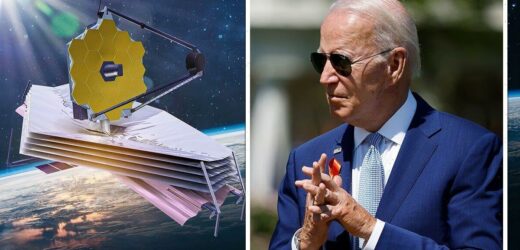Nasa's 'James Webb Space Telescope' launches into orbit
We use your sign-up to provide content in ways you’ve consented to and to improve our understanding of you. This may include adverts from us and 3rd parties based on our understanding. You can unsubscribe at any time. More info
The $10billion (£8.3billion) James Webb Space Telescope (JWST), described as the “world’s most powerful” device of its kind, aside from the most expensive, was launched last Christmas Day. Tonight at 10PM, the US President will unveil the first images ever captured by the observatory, with the powerful telescope being able to capture images that are too distant, faint and old for detection by any other before it, including the famous Hubble Telescope. But where Hubble cast its gaze on the cosmos in the visible spectrum, JWST has been designed to see the faint infrared glow of stars dated to within a few hundred million years of the Bing Bang.
NASA tweeted: “We can’t contain the excitement for @NASAWebb’s first full-colour images!
“President Biden will unveil one of the space telescope’s first images of deep space as a preview of what’s ahead.”
According to NASA, the image revealed by Mr Biden, known as “Webb’s First Deep Field,” will be the deepest and highest-resolution infrared view of the universe ever captured, showing myriad galaxies as they appeared up to 13 billion years in the past.
Tomorrow, NASA, along with its partners at the European and Canadian space agencies, will reveal another batch of full-colour images.
The JWST will help solve some of the universe’s deepest mysteries, the ginormous black hole called Sagittarius Aor Sgr A that lies in the centre of the Milky Way.
The images that have been captured so far have remained a secret, although the scientists who have seen them have reportedly been left in tears.
One of the previously elusive locations that the observatory captured for the launch event is the Carina Nebula, a complex cloud of stars and dust that stretches to be 50-light-year-wide and lies 1000 light-years from earth.
As one of the most active star-forming regions discovered so far, this nebulous cloud is crucial for researchers to understand the origins of the universe as its likely that our solar system emerged from a similar body.
According to Dr Jeffery Kargel of the Planetary Science Institute in Tucson, Arizona, star-forming cloudy regions “are not just beautiful, but they are philosophically mind-blowing and even spiritually stirring when pondering the processes of creation and destruction, and the near-certain origins of life in many, many planets around many stars in the nebula.”
NASA’s scientific missions lead Thomas Zurbuchen said in a press conference: “The images are being taken right now.
“There is already some amazing science in the can, and some others are yet to be taken as we go forward.
“We are in the middle of getting the history-making data down.
DON’T MISS:
Lifeline for millions in Red Wall as fracking return to slash bills [REVEAL]
New Tempest fighter jet to give Britain ‘unassailable lead’ [INSIGHT]
MoD sparks fears as ‘nuclear warheads’ driven down UK motorway [SPOTLIGHT]
“It’s really hard to not look at the universe in a new light and not just have a moment that is deeply personal.
“It’s an emotional moment when you see nature suddenly releasing some of its secrets. and I would like you to imagine and look forward to that.”
Meanwhile, NASA’s deputy administrator Pam Melroy said: “What I have seen moved me, as a scientist, as an engineer, and as a human being.”
Source: Read Full Article







